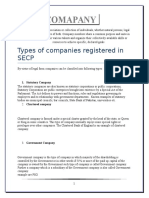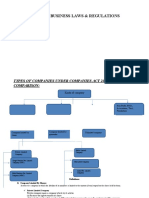Mercantile Law Web Notes
Uploaded by
mf33183829Mercantile Law Web Notes
Uploaded by
mf33183829Mercantile Law (LL.
B-IV)
Mercantile
Law
By:
SHAHID NAEEM
(Gold Medallist)
M.Sc. (Eco), MA(Pol.Sci), MCS, LL.M., DLL
Advocate High Court
Ph : 0321-3614222.
1. Companies Ordinance, 1984 (60 Marks) 3 Questions
(All provisions of the Companies Ordinance, 1984)
2. Partnership Act 1932 (20 Marks) 1 Question
3. The Negotiable Instruments Act, 1881 (20 Marks) 1 Question
(All provisions of Section 1-60, 82-85-A and 122-131 of the Act)
By : Shahid Naeem (0321-3614222) 1
Mercantile Law (LL.B-IV)
COMPANIES ORDINANCE, 1984
Q. Define a Public Limited Company and explain its most distinguishing characteristics.
Ans:
A Public Limited Company (PLC) is a type of business entity that is authorized to offer its
shares to the general public, enabling them to be traded on a public stock exchange. This ability
to raise capital from the public is one of the primary features that differentiate a PLC from other
types of companies. PLCs are essential to the modern economic landscape as they provide a
mechanism for large-scale investments and financing. They are heavily regulated to protect
investors and ensure transparency and accountability in their operations.
DEFINITIONS
A Public Limited Company (PLC) is a type of business structure with distinct features outlined
in legal sources. Here's a breakdown of its definition from various sources:
1. Companies Ordinance, 1984 of Pakistan (Section 15(2)(a))
The Ordinance defines a company as being "with limited liability," and there are three
categories:
Limited by shares
Limited by guarantee
Unlimited
DEFINITIONS FROM LAW DICTIONARIES
Here are definitions of a Public Limited Company (PLC) from some of the resources you
mentioned:
1. Black's Law Dictionary:
A company that trades on the stock exchange. The shares can be traded and sold by any
member of the public. It is governed by a set of strict regulations.
2. Oxford English Dictionary:
"A company that sells shares in itself to the public.
3. Cambridge English Dictionary:
"A business organisation that is recognised by the people who deal with matters such as
buying and selling shares. The shares of a public limited company can be bought and sold by
the public."
KEY CHARACTERISTICS OF A PUBLIC LIMITED COMPANY
Followings are the key characteristics of a public limited company.
1. Limited Liability:
The concept of limited liability means that the shareholders of a PLC are only liable for
the amount they have invested in the company’s shares. They are not personally liable
for the company’s debts and obligations beyond their shareholding.
For instance, if a shareholder has bought shares worth $10,000, their liability is capped
at that amount, even if the company incurs losses that exceed this amount.
By : Shahid Naeem (0321-3614222) 2
Mercantile Law (LL.B-IV)
2. Share Capital:
A PLC must have a minimum share capital requirement, which varies by jurisdiction.
This requirement ensures that the company starts with a sufficient capital base to
undertake its business operations and meet its obligations.
For example, under the Companies Ordinance, 1984 of Pakistan, a PLC must have a
minimum paid-up capital of PKR 200,000.
3. Shares and Shareholders:
Shares in a PLC are freely transferable, meaning they can be bought and sold on public
stock exchanges. This provides liquidity, allowing shareholders to easily enter or exit
their investment.
The ability to have an unlimited number of shareholders helps the company to raise
large amounts of capital, facilitating growth and expansion.
4. Board of Directors:
A PLC is managed by a Board of Directors, elected by the shareholders. The Board is
responsible for the overall governance and strategic direction of the company.
Directors have fiduciary duties to act in the best interests of the company and its
shareholders, making decisions that enhance the company’s value. This governance
structure is detailed in texts like "Principles of Company Law by Pennington R.R."
5. Regulatory Requirements:
Public Limited Companies are subject to stringent regulatory requirements to ensure
transparency and protect investors. These regulations include mandatory disclosure of
financial information, regular audits, and adherence to corporate governance standards.
Compliance with these regulations is critical for maintaining investor trust and ensuring
the smooth functioning of capital markets.
6. Raising Capital:
One of the most significant advantages of a PLC is its ability to raise substantial capital
by issuing shares to the public. This is often done through an Initial Public Offering
(IPO), where shares are sold to institutional and retail investors.
For example, when a company decides to expand its operations, it can raise funds by
offering new shares to the public, thereby gathering the necessary capital without
incurring debt.
7. Perpetual Succession:
A PLC has perpetual succession, meaning it continues to exist even if the ownership or
management changes. The company’s legal identity remains intact irrespective of
changes in shareholders or directors.
This characteristic ensures stability and continuity, allowing the company to undertake
long-term projects and strategies without interruption.
By : Shahid Naeem (0321-3614222) 3
Mercantile Law (LL.B-IV)
8. Legal Entity:
As a separate legal entity, a PLC can own property, enter into contracts, sue, and be
sued in its own name. This separation between the company and its shareholders
protects the personal assets of the shareholders.
The distinct legal identity of a PLC allows it to operate independently of its owners,
facilitating clearer legal and financial arrangements.
Example
Consider "Tech Innovators PLC," a technology company listed on a stock exchange. It offers
its shares to the public, allowing anyone to become a shareholder. The shareholders elect a
Board of Directors to oversee the company's operations and make strategic decisions. Tech
Innovators PLC must publish detailed annual financial reports and adhere to strict regulatory
standards. If the company wants to develop a new product line, it can raise funds by issuing
new shares to the public, providing the necessary capital for innovation and growth.
CONCLUSION
A Public Limited Company is a powerful business structure designed to facilitate large-scale
investment and growth. Its distinguishing characteristics, such as limited liability, the ability to
raise capital through public share offerings, and stringent regulatory oversight, make it an
attractive option for businesses seeking to expand and attract a broad base of investors.
Understanding the nuances of a PLC is crucial for law students studying Mercantile Law, as it
forms the bedrock of corporate finance and governance. These companies play a vital role in
the economy by providing investment opportunities and contributing to economic
development.
******
By : Shahid Naeem (0321-3614222) 4
Mercantile Law (LL.B-IV)
Define a Public limited company and a Partnership and draw a distinction between the
two.(Imp)
Ans:
The world of commerce is built upon a variety of business structures, each with its own
advantages and disadvantages. Two of the most common structures are Public Limited
Companies (PLCs) and partnerships. While both facilitate business activities, they cater to
different needs. This document delves into the key characteristics of PLCs and partnerships,
highlighting the crucial distinctions between these two structures. By understanding the
differences in ownership, liability, regulations, and management, you'll be better equipped to
choose the most suitable structure for your business endeavours.
Understanding the distinctions between a Public Limited Company (PLC) and a Partnership is
crucial for anyone studying Mercantile Law. These two business structures offer distinct
advantages and limitations, and they operate under different legal frameworks.
PUBLIC LIMITED COMPANY (PLC)
A Public Limited Company (PLC) is a type of business entity that offers its shares to the general
public and is usually listed on a stock exchange. It is characterized by its ability to raise capital
from a large number of investors, and it is subject to strict regulatory and disclosure
requirements to protect shareholders.
KEY CHARACTERISTICS OF A PLC:
i. Limited Liability:
Shareholders in a PLC enjoy limited liability, meaning they are only liable for the
amount unpaid on their shares. This protects personal assets from being used to cover
the company’s debts.
For instance, if a shareholder has bought shares worth $10,000, their liability is capped
at that amount, even if the company incurs significant losses.
ii. Share Capital:
A PLC must have a minimum share capital requirement, which varies by jurisdiction.
This requirement ensures that the company starts with a sufficient capital base to
undertake its business operations and meet its obligations.
For example, under the Companies Ordinance, 1984 of Pakistan, a PLC must have a
minimum paid-up capital of PKR 200,000.
iii. Shares and Shareholders:
Shares in a PLC are freely transferable, meaning they can be bought and sold on public
stock exchanges. This provides liquidity, allowing shareholders to easily enter or exit
their investment.
The ability to have an unlimited number of shareholders helps the company to raise
large amounts of capital, facilitating growth and expansion.
iv. Board of Directors:
A PLC is managed by a Board of Directors, elected by the shareholders. The Board is
responsible for the overall governance and strategic direction of the company.
By : Shahid Naeem (0321-3614222) 5
Mercantile Law (LL.B-IV)
Directors have fiduciary duties to act in the best interests of the company and its
shareholders, making decisions that enhance the company’s value.
v. Regulatory Requirements:
Public Limited Companies are subject to stringent regulatory requirements to ensure
transparency and protect investors. These regulations include mandatory disclosure of
financial information, regular audits, and adherence to corporate governance standards.
Compliance with these regulations is critical for maintaining investor trust and ensuring
the smooth functioning of capital markets.
vi. Raising Capital:
One of the most significant advantages of a PLC is its ability to raise substantial capital
by issuing shares to the public. This is often done through an Initial Public Offering
(IPO), where shares are sold to institutional and retail investors.
For example, when a company decides to expand its operations, it can raise funds by
offering new shares to the public, thereby gathering the necessary capital without
incurring debt.
vii. Perpetual Succession:
A PLC has perpetual succession, meaning it continues to exist even if the ownership or
management changes. The company’s legal identity remains intact irrespective of
changes in shareholders or directors.
This characteristic ensures stability and continuity, allowing the company to undertake
long-term projects and strategies without interruption.
viii. Separate Legal Entity:
As a separate legal entity, a PLC can own property, enter into contracts, sue, and be
sued in its own name. This separation between the company and its shareholders
protects the personal assets of the shareholders.
The distinct legal identity of a PLC allows it to operate independently of its owners,
facilitating clearer legal and financial arrangements.
PARTNERSHIP
A Partnership is a business arrangement where two or more individuals (partners) agree to
share the profits and losses of a business carried on by all or any of them acting for all.
Partnerships are typically easier to form and operate under less stringent regulatory frameworks
compared to PLCs.
KEY CHARACTERISTICS OF A PARTNERSHIP:
i. Unlimited Liability:
Partners in a partnership have unlimited liability, meaning they are personally liable for
the debts and obligations of the partnership. This exposes personal assets to risk in case
the business incurs debt or faces legal action.
If the partnership faces financial difficulties, the personal assets of all partners can be
used to settle the business's debts.
By : Shahid Naeem (0321-3614222) 6
Mercantile Law (LL.B-IV)
ii. Capital Contribution:
Partners contribute capital to the business as agreed among themselves. There is no
minimum capital requirement imposed by law, allowing greater flexibility in how the
partnership is financed.
The initial capital and any subsequent contributions are usually outlined in a partnership
agreement.
iii. Management:
A partnership is managed directly by the partners, often with decisions made jointly or
as specified in the partnership agreement. This allows for more direct control over
business operations but can also lead to conflicts if partners disagree.
Each partner typically has an equal say in the management, unless otherwise agreed.
iv. Profit Sharing:
Profits and losses in a partnership are shared among partners as per the terms outlined
in the partnership agreement. This agreement determines each partner’s share based on
their capital contribution, responsibilities, or other factors.
It is common for profits to be distributed equally unless the agreement specifies
otherwise.
v. Regulatory Requirements:
Partnerships generally face fewer regulatory requirements compared to PLCs. They are
not required to publish financial statements or undergo regular audits, making them less
formalized.
This reduced regulatory burden can make partnerships easier and less costly to operate.
vi. Raising Capital:
Capital in a partnership is typically raised through contributions from the partners.
Partnerships cannot issue shares to the public, limiting their ability to raise large
amounts of capital.
Additional capital can be raised by bringing in new partners or through loans.
vii. No Perpetual Succession:
Unlike PLCs, partnerships do not have perpetual succession. The partnership may
dissolve upon the death, withdrawal, or insolvency of a partner unless there is an
agreement in place that allows the remaining partners to continue the business.
The lack of perpetual succession can affect the long-term stability and continuity of the
business.
viii. Not a Separate Legal Entity:
A partnership does not have a separate legal identity from its partners. The partners are
collectively and individually responsible for the business's obligations.
This means that legal actions taken against the partnership are effectively taken against
the partners.
By : Shahid Naeem (0321-3614222) 7
Mercantile Law (LL.B-IV)
Distinctions Between a Public Limited Company and
a Partnership
Here is key differences Between a Public Limited Company and a Partnership.
Public Limited
Nature Partnership
Company (PLC)
A PLC is a separate legal A partnership is not a
entity from its shareholders, separate legal entity. Partners
which means it can enter into are collectively and
Legal Status contracts, own property, and individually responsible for
be sued in its own name. the business’s obligations.
Shareholders have limited Partners have unlimited
liability and are only liable liability and are personally
Liability up to the amount they have responsible for the
invested in the company’s partnership’s debts and
shares. obligations.
Can raise capital by issuing Capital is raised through
shares to the public. This contributions from the
ability to attract investment partners. Partnerships cannot
Capital Raising from a large number of issue shares, limiting their
shareholders is one of the ability to raise large amounts
PLC's key advantages. of capital.
Managed by a Board of Managed directly by the
Directors elected by the partners, who typically make
Management shareholders. The board decisions jointly. This can
Structure makes major decisions and lead to more direct control
oversees the company’s but also potential conflicts.
management.
Subject to stringent Faces fewer regulations and
regulations, including less formal disclosure
mandatory financial requirements, making it
Regulation and
disclosures, regular audits, easier and less costly to
Disclosure and compliance with operate.
corporate governance
standards.
Has perpetual succession, Lacks perpetual succession;
meaning the company the partnership may dissolve
continues to exist regardless if a partner leaves or dies
Perpetual Succession of changes in ownership or unless an agreement allows
management. the remaining partners to
continue.
Profits are distributed to Profits are shared among
shareholders as dividends partners as per the terms of
Profit Sharing based on the number of the partnership agreement,
shares held. which can be based on
By : Shahid Naeem (0321-3614222) 8
Mercantile Law (LL.B-IV)
capital contribution, efforts,
or other agreed factors.
EXAMPLE
a) Public Limited Company (PLC): "Tech Innovators PLC" is listed on a stock
exchange, allowing anyone to buy shares and invest in the company. It is managed by
a Board of Directors, and its financial health is regularly audited and disclosed to the
public. Shareholders enjoy limited liability and can trade their shares freely. If Tech
Innovators PLC needs to raise capital for expansion, it can issue new shares to the
public, attracting investment from a wide pool of investors.
b) Partnership: "Smith & Jones LLP" is a law firm where both Smith and Jones have
agreed to share profits and losses equally. They contribute capital as needed and make
management decisions together. If the partnership incurs debts, both Smith and Jones
are personally liable. The partnership may dissolve if either partner decides to leave,
unless they have an agreement in place that allows the remaining partner to continue
the business.
CONCLUSION
While both Public Limited Companies and Partnerships have their unique advantages and
challenges, the choice between the two depends largely on the nature of the business, the level
of regulatory compliance one is willing to undertake, and the degree of personal liability the
business owners are prepared to accept. Understanding these distinctions is fundamental for
law students and business professionals alike, as it influences the strategic decisions related to
business formation and operation. Public Limited Companies are suitable for businesses
looking to raise large amounts of capital and willing to adhere to strict regulatory standards,
while Partnerships offer a simpler, more flexible structure for businesses where personal
liability and close collaboration are feasible.
******
By : Shahid Naeem (0321-3614222) 9
Mercantile Law (LL.B-IV)
Q. What is Memorandum of Association? Explain the methods and limits in which a Public
Limited company can alter the Object Clause of its Memorandum of Association. (Imp)
Q. What is Memorandum of Association of a Public Limited Company? What are its
essential clauses? Discuss each one of them in detail.
Ans:
The bedrock of a Public Limited Company (PLC) lies in its Memorandum of Association
(MOA). This foundational document serves as more than just a formality during incorporation;
it dictates the very essence of the company's existence. Beyond its role as a birth certificate,
the MOA acts as a constitution, defining the PLC's core purpose, operational framework, and
limitations. This comprehensive analysis delves into the intricacies of each essential clause
within the MOA, illuminating their significance and the crucial role they play in shaping the
PLC's journey. By dissecting these clauses, we gain a deeper understanding of how the MOA
safeguards shareholders, informs stakeholders, and establishes the boundaries within which the
PLC can operate.
MEMORANDUM OF ASSOCIATION OF A PUBLIC LIMITED
COMPANY IN PAKISTAN
The Memorandum of Association (MOA) is a fundamental legal document in the formation of
a Public Limited Company (PLC) in Pakistan. It outlines the company's constitution, purpose,
and scope of activities, serving as a binding charter that governs its relationship with
shareholders and the public. The MOA is required by the Companies Ordinance, 1984 (now
replaced by the Companies Act, 2017) and must be filed with the Securities and Exchange
Commission of Pakistan (SECP) during the company's incorporation process.
ESSENTIAL CLAUSES OF THE MEMORANDUM OF ASSOCIATION
Here we will discuss Essential Clauses of the Memorandum of Association(MoA).
1. Name Clause
This clause specifies the official name of the company. In Pakistan, the name must end
with "Limited" to signify its status as a limited company.
Example: "Pakistan Steel Mills Limited"
The name must be unique, not misleading, and should comply with SECP regulations,
which prohibit names that suggest a connection with government or offend public
morals.
2. Registered Office Clause
This clause states the physical address of the company’s registered office in Pakistan.
This is where all legal documents and official communications are sent.
Example: "Pakistan Steel Mills Limited, 19-K, Industrial Area, Karachi"
The registered office address must be within the jurisdiction where the company is
registered, and any change in this address must be promptly notified to the SECP.
By : Shahid Naeem (0321-3614222) 10
Mercantile Law (LL.B-IV)
3. Object Clause
The object clause defines the specific purposes for which the company is established
and outlines the activities it is authorized to undertake. This is crucial as any activity
beyond these objects is considered ultra vires (beyond the powers) and is invalid.
Example: "To manufacture, process, and sell steel and related products in Pakistan and
abroad."
In Pakistan, it is common for companies to include a wide range of ancillary activities
to provide flexibility in operations.
4. Liability Clause
This clause outlines the extent of liability of the company’s members. For a PLC, the
liability of shareholders is limited to the amount unpaid on their shares.
Example: "The liability of the members is limited to the amount, if any, unpaid on the
shares respectively held by them."
This protection encourages investment by limiting the financial risk for shareholders.
5. Capital Clause
The capital clause specifies the total amount of share capital with which the company
is registered and the division of this capital into shares of a fixed amount.
Example: "The share capital of the company is Rs. 500,000,000 divided into 50,000,000
shares of Rs. 10 each."
This clause also details the different classes of shares (e.g., ordinary, preference) and
their respective rights.
6. Association Clause
This clause contains a declaration by the initial subscribers (founding members) of their
intention to form the company and their agreement to take up the shares specified.
Example: "We, the several persons whose names and addresses are subscribed, are
desirous of being formed into a company in pursuance of this Memorandum of
Association, and we respectively agree to take the number of shares in the capital of the
company set opposite our respective names."
In Pakistan, at least seven subscribers must sign this clause for a PLC, and each must subscribe
to at least one share.
DETAILED DISCUSSION OF EACH CLAUSE
1. Name Clause:
The name clause establishes the company's identity and must be unique and compliant
with the SECP’s naming guidelines. A unique name helps prevent confusion and
ensures clear branding.
Example: "National Refinery Limited" clearly indicates the company's industry and
status as a PLC.
Names suggesting state patronage (e.g., using words like "Federal" or "Republic") or
those implying illegal activities are prohibited.
By : Shahid Naeem (0321-3614222) 11
Mercantile Law (LL.B-IV)
2. Registered Office Clause:
The registered office clause ensures that there is a fixed physical location where the
company’s statutory books and records are kept and where legal documents can be
served.
Example: "National Refinery Limited, Plot No. 5, Korangi Industrial Area, Karachi."
This address must be current, and any changes must be communicated to the SECP to
ensure all legal communications reach the company promptly.
3. Object Clause:
The object clause defines the company's business scope and legal capacity. In Pakistan,
companies often draft broad object clauses to include various ancillary activities,
providing flexibility.
Example: "To engage in the business of oil refining, marketing petroleum products, and
establishing refineries and ancillary facilities."
This allows the company to expand its activities without requiring frequent
amendments to the MoA.
4. Liability Clause:
The liability clause limits shareholders’ financial risk to the unpaid amount on their
shares. This is crucial for attracting investors, as it provides a safeguard against personal
financial loss.
Example: If a shareholder owns 1,000 shares of Rs. 10 each, and has paid Rs. 8 per
share, their liability is limited to Rs. 2,000 (the unpaid amount).
This clause is pivotal in promoting investment by reducing personal risk.
5. Capital Clause:
The capital clause outlines the company’s financial structure, detailing the authorized
share capital and its division into shares.
Example: "The share capital of National Refinery Limited is Rs. 1,000,000,000 divided
into 100,000,000 ordinary shares of Rs. 10 each."
It also includes information about different types of shares (e.g., preference shares) and
the rights attached to them, such as voting rights, dividend entitlements, and liquidation
preferences.
6. Association Clause:
The association clause is a declaration by the initial subscribers expressing their intent
to form the company and their commitment to purchase a specified number of shares.
Example: "We, the undersigned, are desirous of being formed into a company in
pursuance of this Memorandum of Association and agree to take the shares set opposite
our names."
In Pakistan, this clause requires at least seven subscribers for a PLC, each subscribing
to at least one share, thus legitimizing the company’s incorporation.
By : Shahid Naeem (0321-3614222) 12
Mercantile Law (LL.B-IV)
AMENDING THE OBJECT CLAUSE OF A PUBLIC LIMITED
COMPANY'S MOA IN PAKISTAN:
The Object Clause of a Public Limited Company's (PLC) Memorandum of Association (MoA)
serves as its foundational blueprint, outlining the company's authorized business activities and
the powers it can exercise. However, the business landscape is dynamic, and circumstances
may arise where a PLC needs to adapt its core objectives. This document delves into the
methods and limitations associated with altering the Object Clause in a Pakistani PLC, drawing
upon relevant provisions of the Companies Ordinance, 1984 (the Ordinance) and exploring the
role of the Securities and Exchange Commission of Pakistan (SECP).
METHODS FOR ALTERING THE OBJECT CLAUSE:
1. Special Resolution:
This is the most common and preferred method for amending the Object Clause in Pakistan.
Here's a detailed breakdown of the process:
i. Board Initiative:
The process typically begins with the company's board of directors recognizing the need
to modify the Object Clause. The board formally proposes an amendment resolution,
outlining the specific changes they recommend.
ii. Shareholder Communication:
Once the board approves the proposed amendment, a crucial step involves clear
communication with shareholders. The company must prepare and distribute a notice
convening an Extraordinary General Meeting (EGM) specifically for the purpose of
considering the proposed amendment to the Object Clause. This notice should be sent
to all shareholders well in advance of the EGM, providing ample time for review and
consideration. The notice should clearly detail the proposed changes to the Object
Clause, explaining the rationale behind the amendment and its potential impact on the
company's operations and future direction.
iii. Extraordinary General Meeting (EGM):
At the EGM, shareholders have the opportunity to discuss, debate, and ultimately vote
on the proposed amendment. To ensure a fair and transparent process, the voting
requirements for altering the Object Clause are typically stricter than those for ordinary
matters. The Companies Ordinance generally requires a special resolution to be passed,
which in most cases translates to a 75% majority vote of the shareholders present and
voting at the EGM. This higher voting threshold ensures that significant changes to the
company's core purpose have the backing of a substantial majority of shareholders.
2. Court Order:
While less common, a PLC may seek a court order to modify its Object Clause under
exceptional circumstances. This course of action might be necessary if:
i. Impractical or Illegal Clause:
The current Object Clause is deemed impractical or even illegal in light of changing
regulations or unforeseen circumstances.
By : Shahid Naeem (0321-3614222) 13
Mercantile Law (LL.B-IV)
ii. Significant Hindrance:
The existing Object Clause poses a significant hurdle to the company's ability to pursue
legitimate business opportunities that fall outside the strictly defined scope of the
current clause.
However, obtaining a court order is a more complex and time-consuming process compared to
a special resolution. It involves filing a petition with the court, presenting compelling
arguments for the amendment, and potentially facing objections from stakeholders. The court
will carefully consider the merits of the case before issuing an order to modify the Object
Clause.
LIMITS ON ALTERING THE OBJECT CLAUSE:
While some flexibility exists, there are limitations on how a PLC can alter its Object Clause,
ensuring responsible and measured changes that safeguard stakeholder interests. Here are some
key restrictions:
i. Ultra Vires Doctrine:
The amendment cannot be "ultra vires," meaning it cannot exceed the company's
powers as defined by the Companies Ordinance and other relevant legislation. The
Object Clause cannot be amended in a way that authorizes activities fundamentally
outside the scope of a PLC's legal existence. For instance, a company formed for the
sole purpose of manufacturing pharmaceuticals cannot amend its Object Clause to
include activities like operating a bank. This would be considered a clear violation of
the ultra vires doctrine.
ii. Protection of Creditors and Investors:
The amendment should not unfairly prejudice the interests of the company's creditors
or existing shareholders. Any changes to the Object Clause should be reasonable and
undertaken in good faith, considering the potential impact on all stakeholders. For
example, an amendment granting exclusive voting rights to a specific class of
shareholders might be deemed unfair to other shareholder classes, exceeding the limits
of reasonable alterations to the Object Clause.
iii. Prior Sanction of the SECP:
The Companies Ordinance might require prior approval from the SECP for certain
types of amendments, particularly those involving significant changes to the company's
core business activities. The SECP plays a vital role in protecting investors and ensuring
transparency in the corporate sector. By requiring prior approval for certain
amendments, the SECP can assess the potential impact on investors and ensure that the
proposed changes comply with relevant regulations. For instance, if a company
proposes a major shift in its business focus, for instance, from telecommunications to
mining, it might require SECP approval to ensure transparency and protect investors
who may have invested based on the original Object Clause.
EXAMPLES OF EXCEEDING LIMITS:
Here are some more detailed examples of applying the limitations when amending the Object
Clause of a Public Limited Company's MoA in Pakistan:
By : Shahid Naeem (0321-3614222) 14
Mercantile Law (LL.B-IV)
1. Ultra Vires Doctrine:
Scenario: A company formed for the purpose of "manufacturing and supplying educational
toys" wants to amend its Object Clause to include "operating a chain of casinos."
Limitation: This amendment would be considered ultra vires. Operating a casino falls outside
the scope of educational toys and is not a legitimate business activity for the company as
originally constituted. The company's powers do not extend to gambling activities.
2. Protection of Stakeholders:
Scenario: A company has two classes of shareholders: Class A with voting rights and Class B
with no voting rights. The company proposes an amendment to grant exclusive voting rights
only to Class A shareholders, effectively silencing the voices of Class B shareholders.
Limitation: This amendment might be challenged on the grounds of unfairly prejudicing Class
B shareholders. While some difference in shareholder rights is permissible, completely
stripping voting rights from a class might be deemed excessive and not in good faith.
3. Prior Sanction of the SECP:
Scenario: A company primarily involved in "online retail sales of clothing" wants to amend
its Object Clause to include "acquiring a controlling stake in a major brick-and-mortar retail
chain."
Limitation: This amendment might require prior approval from the SECP. Shifting from
online retail to a focus on brick-and-mortar operations represents a significant change in
business strategy. SECP approval would ensure transparency and protect investors who may
have invested in the company based on its original online model. The SECP would likely want
to assess the company's preparedness for such a major shift and its potential impact on
shareholders.
CONCLUSION
The Memorandum of Association is a foundational document for a Public Limited Company
in Pakistan, outlining its core principles, objectives, and operational framework. Each clause
serves a vital role in defining the company's identity, legal capacity, and governance structure.
Understanding these clauses is essential for law students, business professionals, and anyone
involved in company formation and management, as they provide the legal foundation upon
which the company operates and interacts with its stakeholders. In Pakistan, adhering to the
guidelines set by the SECP and ensuring comprehensive and clear drafting of the MoA are
crucial steps in the successful establishment and operation of a PLC.
******
By : Shahid Naeem (0321-3614222) 15
Mercantile Law (LL.B-IV)
Q. Define 'Share'. How allotment of a share in public limited company is made? What
restrictions are imposed on such allotment?
Ans:
The lifeblood of a Public Limited Company (PLC) in Pakistan flows through its shares. These
units of ownership represent not just a financial stake, but also a connection to the company's
journey. Understanding how shares work and the process of acquiring them is crucial for both
aspiring investors and those seeking to navigate the Pakistani capital market. This analysis
delves into the concept of shares in Pakistani PLCs, exploring their characteristics, types, and
the value factors that influence them. We will then dissect the allotment process, from the initial
prospectus issuance to the final notification received by successful applicants. By examining
the regulations set forth by the Securities and Exchange Commission of Pakistan (SECP) and
considering factors like pre-emption rights, we gain a comprehensive picture of how shares are
allocated in Pakistani PLCs. This knowledge empowers investors to make informed decisions
and participate effectively in the dynamic world of Pakistani equities.
WHAT IS 'SHARE'?
A 'share' in the context of a Public Limited Company (PLC) represents a unit of ownership
interest in the company. Shares constitute the share capital of the company and are a measure
of the interest a shareholder has in the company’s assets, profits, and liabilities. Each share
grants certain rights to the shareholder, including voting rights, dividends, and a claim on the
company’s residual assets upon liquidation. Shares can be categorized into various types, such
as ordinary shares, preference shares, and deferred shares, each conferring specific rights and
privileges.
KEY FEATURES OF A SHARE
Here we will discuss the key features of a “Share”.
1. Ownership:
A share signifies a proportionate ownership stake in the company.
Example: Owning 1,000 shares in a company with 1,000,000 shares outstanding means
owning 0.1% of the company.
2. Rights:
Shareholders are entitled to certain rights, such as voting rights, dividend rights, and
rights on liquidation.
Example: Ordinary shares typically grant voting rights in the company's annual general
meeting (AGM), where shareholders can vote on key issues such as electing the board
of directors.
3. Transferability:
Shares are generally transferable, allowing shareholders to sell or transfer their shares
to others.
Example: Shares of a PLC listed on a stock exchange, such as the Pakistan Stock
Exchange (PSX), can be bought and sold freely by the public.
By : Shahid Naeem (0321-3614222) 16
Mercantile Law (LL.B-IV)
4. Dividends:
Shareholders may receive a portion of the company’s profits in the form of dividends,
depending on the type of share they hold and the company’s dividend policy.
Example: Preference shares often carry a fixed dividend rate, while ordinary shares may
receive variable dividends based on the company’s performance.
5. Residual Claims:
In the event of liquidation, shareholders have a residual claim on the company’s assets
after all debts and liabilities have been paid.
Example: If a company is liquidated, any remaining assets are distributed to
shareholders in proportion to their shareholdings.
ALLOTMENT OF SHARES IN A PUBLIC LIMITED COMPANY
Allotment of shares is the process through which a Public Limited Company distributes its
shares to applicants. The process involves several steps and must comply with regulatory
requirements to ensure fairness and transparency.
Steps in the Allotment Process
1. Application:
o Prospective investors apply for shares through an application form issued by
the company, often during an Initial Public Offering (IPO) or a subsequent
public offering.
o Example: During an IPO, the company issues a prospectus detailing the terms
of the offer, inviting the public to subscribe.
2. Allotment Decision:
o The company’s Board of Directors reviews the applications and decides the
number of shares to be allotted to each applicant. This decision is often
influenced by the level of subscription (whether it is under-subscribed, fully
subscribed, or over-subscribed).
o Example: If a company receives applications for more shares than it has
available, it may allot shares on a pro-rata basis.
3. Allocation and Communication:
o The company allocates shares to the applicants and informs them of the
allotment through an allotment letter. This letter specifies the number of shares
allotted and the payment details.
o Example: An allotment letter may state that an applicant who applied for
1,000 shares has been allotted 800 shares.
4. Payment:
o Applicants must pay for the allotted shares as per the terms specified in the
allotment letter. Payment can be in full or in installments, depending on the
company's policy.
o Example: An applicant may need to pay the full price per share within a
specified period to confirm their allotment.
5. Issuance of Share Certificates:
o After payment is received, the company issues share certificates to the
shareholders, or in case of dematerialized shares, the shares are credited to the
investor’s account with a depository.
By : Shahid Naeem (0321-3614222) 17
Mercantile Law (LL.B-IV)
o Example: A shareholder receives a digital confirmation from the Central
Depository Company (CDC) in Pakistan.
RESTRICTIONS ON ALLOTMENT OF SHARES
Several restrictions are imposed on the allotment of shares to ensure legality, transparency, and
protection of investors. These restrictions are guided by regulations such as the Companies
Act, 2017 in Pakistan. Key Restrictions are given below:
1. Minimum Subscription:
o A company must receive a minimum subscription amount before making any
allotment. This ensures that sufficient capital is raised to carry out the business
objectives.
o Example: If the minimum subscription is not achieved, the company must
refund all application money received.
2. Disclosure Requirements:
o Full disclosure of the company’s financial status, business model, risks, and
other material information must be provided to potential investors through a
prospectus.
o Example: The prospectus should comply with the SECP's disclosure standards
to protect investors' interests.
3. Payment on Allotment:
o No shares can be allotted unless the company has received the minimum
amount payable on each share, as specified in the application.
o Example: If the application form specifies a 10% down payment on
application, this amount must be collected before allotment.
4. SECP Approval:
o In certain cases, especially for new issues, the allotment may require approval
from the Securities and Exchange Commission of Pakistan (SECP).
o Example: A new share issue might need to be vetted by the SECP to ensure
compliance with legal and regulatory standards.
5. No Allotment to Minors:
o Shares cannot be allotted to minors (individuals below the age of 18) as they
cannot legally enter into contracts.
o Example: An application submitted by a minor must be either rejected or
processed in the name of a guardian.
6. Non-Compliance Penalties:
o Any allotment made without adhering to the legal requirements may be
deemed void or voidable, and the company could face penalties.
o Example: If a company allots shares without achieving the minimum
subscription, it could be compelled to refund the money and face regulatory
action.
DETAILED EXPLANATION OF THE ALLOTMENT PROCESS
1. Application Phase:
o During an IPO or a subsequent public offering, the company issues a
prospectus that details the offer, including the number of shares available, the
price per share, and the application process. Prospective investors submit their
applications along with the required payment.
By : Shahid Naeem (0321-3614222) 18
Mercantile Law (LL.B-IV)
o Example: A company offering 1,000,000 shares at Rs. 10 each will issue a
prospectus inviting the public to subscribe. Investors fill out application forms
and submit them with payment to designated banks or financial institutions.
2. Allotment Decision:
o Once the application period closes, the company's board of directors reviews
the applications. If the offer is over-subscribed, meaning more applications are
received than the number of shares available, the company may decide to allot
shares on a pro-rata basis or use a lottery system to allocate shares fairly.
o Example: If 2,000,000 shares are applied for but only 1,000,000 are available,
the company may decide to allot 50% of the applied shares to each applicant.
3. Allocation and Communication:
o The company prepares an allotment list and issues allotment letters to
successful applicants. This letter details the number of shares allotted, the
amount due (if any), and instructions for completing the payment process.
o Example: An investor who applied for 1,000 shares and was allotted 800 will
receive an allotment letter indicating the number of shares and the payment
schedule.
4. Payment Process:
o Applicants must pay the remaining amount (if any) as specified in the
allotment letter. This can involve paying the full amount upfront or making
instalments.
o Example: If the share price is Rs. 10 and the investor paid Rs. 5 on
application, they must pay the remaining Rs. 5 per share within the stipulated
time to confirm their allotment.
5. Issuance of Share Certificates:
o Once the payment is received, the company issues share certificates to the
shareholders, or in the case of dematerialized shares, credits the shares to the
investor’s account with a depository like the Central Depository Company
(CDC) in Pakistan.
o Example: An investor receives an electronic confirmation from CDC
indicating that their account has been credited with 800 shares of the
company.
CONCLUSION
Shares are fundamental units of ownership in a Public Limited Company, offering various
rights and privileges to shareholders. The allotment of shares is a carefully regulated process
designed to ensure fairness, transparency, and protection for investors. Understanding the
detailed steps and restrictions involved in share allotment is crucial for anyone studying
company law or involved in corporate governance. In Pakistan, these processes are governed
by the Companies Act, 2017, and overseen by the SECP, ensuring a robust legal framework
for the issuance and allotment of shares.
******
By : Shahid Naeem (0321-3614222) 19
Mercantile Law (LL.B-IV)
By : Shahid Naeem (0321-3614222) 20
You might also like
- Difference Between Public Limited Company and Private Limited Company 2025.03.17 15.09.59No ratings yetDifference Between Public Limited Company and Private Limited Company 2025.03.17 15.09.591 page
- Difference Between A Private LTD and Public LTD0% (1)Difference Between A Private LTD and Public LTD4 pages
- Public Limited and Private Limited CompaniesNo ratings yetPublic Limited and Private Limited Companies5 pages
- Planning To Start A Private Limited CompanyNo ratings yetPlanning To Start A Private Limited Company5 pages
- Different Between A Private Limited Company and A Public Limited CompanyNo ratings yetDifferent Between A Private Limited Company and A Public Limited Company2 pages
- Limited Companies & Multinationals GuideNo ratings yetLimited Companies & Multinationals Guide15 pages
- Statutory and Legal Requirements For Starting Company100% (1)Statutory and Legal Requirements For Starting Company9 pages
- Differences Between A Private Vs Public Company100% (1)Differences Between A Private Vs Public Company7 pages
- Sole Proprietorship: Types of Industry OwnershipNo ratings yetSole Proprietorship: Types of Industry Ownership10 pages
- Types of Corporations: Accounting Unit 1No ratings yetTypes of Corporations: Accounting Unit 122 pages
- Victory 500 Index Fund 4Q 2024 - Fund FactsNo ratings yetVictory 500 Index Fund 4Q 2024 - Fund Facts2 pages
- Capital Structure Analysis of HDFC BankNo ratings yetCapital Structure Analysis of HDFC Bank23 pages
- How Much Does Registering A Franchise Business CostNo ratings yetHow Much Does Registering A Franchise Business Cost3 pages
- Ultimate Guide For Mutual Fund InvestingNo ratings yetUltimate Guide For Mutual Fund Investing19 pages
- The Great Bank Heist: How Fractional Reserve Banking and Fiat Currency Rob The World - and How We Can Break FreeNo ratings yetThe Great Bank Heist: How Fractional Reserve Banking and Fiat Currency Rob The World - and How We Can Break Free49 pages
- DGKC, KOHC & ACPL - 2QFY25 Result PreviewsNo ratings yetDGKC, KOHC & ACPL - 2QFY25 Result Previews3 pages
- Excel Price Feed Yahoo Finance FormulasNo ratings yetExcel Price Feed Yahoo Finance Formulas52 pages
- GSEB 12th BA Question Bank (EM) (2024-25) (DEO Ahmedabad) (VisionPapers - Org)No ratings yetGSEB 12th BA Question Bank (EM) (2024-25) (DEO Ahmedabad) (VisionPapers - Org)30 pages
- Cassa Di Compensazione e Garanzia Spa Financial Statement 31.12.2022 EngNo ratings yetCassa Di Compensazione e Garanzia Spa Financial Statement 31.12.2022 Eng107 pages
























































































